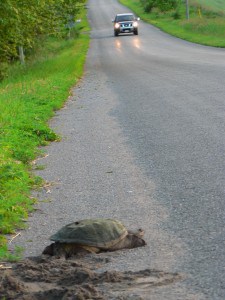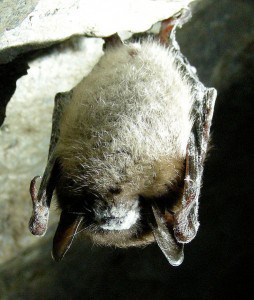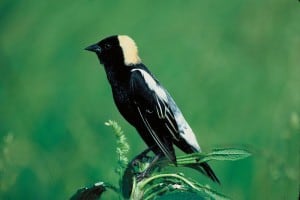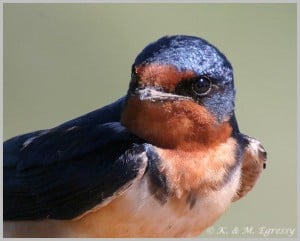Myriad threats and declines evident in the Kawarthas, too
Living in a country as big and relatively unpopulated as Canada, it might come as a surprise that much of our wildlife is in serious decline. This was made abundantly clear last week when World Wildlife Fund Canada (WWF) released its annual Living Planet Report.
WWF studied 3,689 population trends for 903 monitored vertebrate species (mammals, fish, birds, amphibians and reptiles) in Canada, for the period 1970 to 2014. Using this database, they developed a national Living Planet Index – similar to a stock market index – to reflect how Canada’s wildlife is faring. The findings surprised even WWF: Half of the monitored species (451 of 903) are in decline, and of these declining species, the average drop is a whopping 83 per cent. Even more surprising, the numbers for at-risk species – those protected by the Species at Risk Act, or SARA – are even worse. SARA-listed populations have continued to decrease by an average of 28% and the rate of decline is actually increasing – all of this, despite protections afforded by the act.
Mammal populations have decreased by 41%, fish by 20% and reptiles and amphibians by 34%. Although overall bird populations have increased slightly, there are widely differing trends. Since 1970, grassland birds (e.g., bobolinks, meadowlarks) have plunged 69%, aerial foragers (e.g., swallows, swifts, flycatchers) have fallen 51% and shorebirds (e.g., plovers, sandpipers) have decreased by 43 %.
One of the most troublesome population declines in Canada’s central region, which includes Ontario, is that of reptiles and amphibians. These include snakes, turtles, lizards, frogs and salamanders. The study looked at 73 monitored populations of 28 species. Habitat loss, in combination with fragmentation (i.e., dividing the landscape up into smaller and more isolated parts), road mortality and pollution are some of the major threats to these animals. Freshwater fish have also taken a beating. Looking just at Lake Ontario, fish populations declined 32 per cent, on average, between 1992 and 2014. Later this fall, I hope to do a column on the status of local fish populations.
Losses in the Kawarthas
Unfortunately, the Kawarthas is not immune to these declines, either. A brief look at four iconic species is very telling.
1. Snapping turtle: Although snapping turtles can live for more than a century, they take up to 20 years to reach breeding age. Therefore, the loss of even one turtle can have a big impact on the population. Threats include habitat loss and degradation as well as road mortality. This year has seen a huge spike in turtle deaths and injuries, mostly because of collisions with cars and boats. As of August 16, the total number of turtles brought to the Ontario Turtle Conservation Centre in Peterborough was close to 800! This included 273 snapping turtles. The Centre has never seen so many injured or dead turtles. One very large snapping turtle was classified as “attacked by human”. A large metal rod was removed from the turtle’s shell, but internal injuries led to its demise. Snapping turtles are currently listed as a species of Special Concern under SARA.
2. Little brown bat: Bats have been suffering for years from habitat destruction and persecution. Now, they are up against white-nose syndrome, a fungal disease that arrived in the Kawarthas about six years ago. The disease causes the bats to awaken too early from their winter sleep. Early awakening depletes their body reserves of stored water, electrolytes and fat, and they end up dying. White-nose syndrome has already wiped out 94 per cent of little brown bats in eastern Canada. This may be the most rapid mammal decline ever documented. Large numbers of little brown bats used to overwinter in abandoned mine shafts in the Bancroft area and even some in the Warsaw Caves. The little brown bat was emergency-listed as Endangered under SARA in 2014.
3. Bobolink: These sparrow-like birds are a joy to see and hear. The males have a distinctive jet-black front and big patches of white. They were once a common sight in meadows nearly everywhere in the Kawarthas. The intensification of farming operations, however, has resulted in widespread loss and deterioration of their old field and meadow habitat. Because they nest in hay fields, they often lose their eggs or young to mowing. Bobolink populations in Canada have crashed by 88 per cent in just 40 years. In 2017, a SARA listing was proposed for this species as Threatened.
4. Barn Swallow: For anyone growing up on a farm or spending time at a cottage in the Kawarthas, barn swallows used to be a constant presence in summer. They would dart gracefully over fields, barnyards and open water, swooping effortlessly to catch insects. They were taken as much for granted as robins are now. Between 1970 and 2014, barn swallows declined by 66 percent in Ontario. Although not yet fully understood, the causes for the decline include loss of nesting and feeding habitat, along with what appears to be a reduction in insect numbers. Insect decline may be linked to pesticides, which often end up in water bodies where insects breed. Barn swallows are now listed as “threatened” on the Species at Risk list in Ontario. This means that the bird is likely to become endangered if the appropriate steps are not taken.
As we have seen from these profiles, wildlife declines are being driven primarily by habitat loss. This comes mostly from the impacts of forestry, agriculture, urbanization and industrial development. Other threats include climate change (Canada’s warming is twice the global average); pollution (e.g., pesticides, agricultural runoff, heat and noise pollution); invasive species (e.g., zebra mussels) and unsustainable harvest (e.g., overfishing). These effects are cumulative and cascading. For example, changes in the status of one species (e.g., insects) often lead to changes in others (e.g., insect-eating birds).
You don’t have to look far to see these threats playing out in the Kawarthas. Regardless of the merits of a given project or practice, wildlife are almost always on the losing end. In terms of habitat loss, housing developments (e.g., Lily Lake, Television Road, Millbrook) destroy habitat for grassland birds; hedgerow removal (e.g., Keene area) is eliminating nesting sites for birds as well as pollinators; widening Rye Street will undoubtedly impact Harper Creek brook trout; new or expanded cottages and homes on the Kawartha Lakes is degrading nesting habitat for loons and spawning sites for walleye; a proposed housing development adjacent to Loggerhead Marsh will almost certainly effect amphibians; population growth, along with new roads (e.g., 407 extension, widening of Pioneer Road ) is resulting in more road mortality for turtles; Peterborough’s new casino will degrade the habitat value of Harper Park because of light and noise pollution, along with increased traffic; and the replacement of old barns with new, less nesting-friendly structures, is impacting barn swallows. Non-native invasive species such as Phragmites and dog-strangling vine are thriving in the Kawarthas and choking out native vegetation in the process. Another invasive, the emerald ash borer, is decimating ash trees. Climate change, which actually accelerates the growth of many invasive plants, is already making the Kawarthas too warm for formerly common birds like gray jays. Climate change-related weather extremes, such as the drought we experienced last summer, are further weakening many tree species, which are already under siege by fungal diseases. These include butternut, beech and elms.
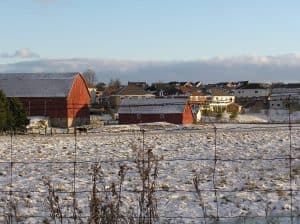
The relentless march of housing developments into rural land. Parkhill Road at Ravenwood Drive in Peterborough, Ontario (Drew Monkman photo)
Taking Action
The findings of WWF-Canada’s national Living Planet Report make it clear we need to do more to protect species at risk. We also need to halt the decline of other wildlife before they land on the at-risk list in the first place. We need action from communities, industry, government and individuals. As a nation, we need to do a better job collecting and sharing data on ecosystem health and species habitat. We must also enhance research on the impacts of, and response to, climate change; strengthen implementation of the Species at Risk Act and shift toward ecosystem-based action plans instead of a species-based approach. Expanding Canada’s network of protected areas is also crucial.
None of this will happen – or happen fast enough – unless more Canadians make a personal commitment to nature. Individual action is powerful, especially when your neighbours, friends and family see you stepping up. So, what can you do?
1. Most importantly, be careful who you vote for. Support parties and candidates who put environmental values such as wildlife conservation and climate change measures front and centre. Be sure your vote goes to politicians who value green space and will fight for adequate funding of government agencies like MNR and Parks Canada. Maybe run for office yourself!
2. Give money. In the U.S. last year, environmental giving represented only 3% of all charitable donations. I doubt the numbers are much different in Canada. If you want to give locally, consider the Kawartha Land Trust or the Ontario Turtle Conservation Centre.
3. Take direct action. You can do this by planting pollinator gardens, stopping for turtles, removing invasive species or participating in a Citizen Science project in which you monitor species. The possibilities are endless.
4. Encourage your child’s teacher and principal to provide nature and outdoor education opportunities for students.
5. Be a role model. Show interest, enthusiasm and concern for nature. It’s contagious.
6. Going forward, we all need to consider whether it’s really possible to maintain healthy and diverse wildlife populations in a society based on continual economic growth – no matter how green future energy sources might be. We might be kidding ourselves.
